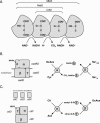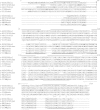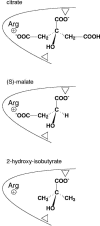The 2-hydroxycarboxylate transporter family: physiology, structure, and mechanism
- PMID: 16339740
- PMCID: PMC1306803
- DOI: 10.1128/MMBR.69.4.665-695.2005
The 2-hydroxycarboxylate transporter family: physiology, structure, and mechanism
Abstract
The 2-hydroxycarboxylate transporter family is a family of secondary transporters found exclusively in the bacterial kingdom. They function in the metabolism of the di- and tricarboxylates malate and citrate, mostly in fermentative pathways involving decarboxylation of malate or oxaloacetate. These pathways are found in the class Bacillales of the low-CG gram-positive bacteria and in the gamma subdivision of the Proteobacteria. The pathways have evolved into a remarkable diversity in terms of the combinations of enzymes and transporters that built the pathways and of energy conservation mechanisms. The transporter family includes H+ and Na+ symporters and precursor/product exchangers. The proteins consist of a bundle of 11 transmembrane helices formed from two homologous domains containing five transmembrane segments each, plus one additional segment at the N terminus. The two domains have opposite orientations in the membrane and contain a pore-loop or reentrant loop structure between the fourth and fifth transmembrane segments. The two pore-loops enter the membrane from opposite sides and are believed to be part of the translocation site. The binding site is located asymmetrically in the membrane, close to the interface of membrane and cytoplasm. The binding site in the translocation pore is believed to be alternatively exposed to the internal and external media. The proposed structure of the 2HCT transporters is different from any known structure of a membrane protein and represents a new structural class of secondary transporters.
Figures













Similar articles
-
Secondary transporters of the 2HCT family contain two homologous domains with inverted membrane topology and trans re-entrant loops.FEBS J. 2005 May;272(9):2334-44. doi: 10.1111/j.1742-4658.2005.04665.x. FEBS J. 2005. PMID: 15853816
-
Domain structure and pore loops in the 2-hydroxycarboxylate transporter family.J Mol Microbiol Biotechnol. 2006;11(6):318-25. doi: 10.1159/000095634. J Mol Microbiol Biotechnol. 2006. PMID: 17114896 Review.
-
Functional importance of GGXG sequence motifs in putative reentrant loops of 2HCT and ESS transport proteins.Biochemistry. 2009 Aug 11;48(31):7448-56. doi: 10.1021/bi9004914. Biochemistry. 2009. PMID: 19594131
-
Conserved residues R420 and Q428 in a cytoplasmic loop of the citrate/malate transporter CimH of Bacillus subtilis are accessible from the external face of the membrane.Biochemistry. 2003 Jan 21;42(2):467-74. doi: 10.1021/bi026874a. Biochemistry. 2003. PMID: 12525174
-
Structural and mechanistic diversity of secondary transporters.Curr Opin Microbiol. 2005 Apr;8(2):161-7. doi: 10.1016/j.mib.2005.02.005. Curr Opin Microbiol. 2005. PMID: 15802247 Review.
Cited by
-
Membrane transporters in the bioproduction of organic acids: state of the art and future perspectives for industrial applications.FEMS Microbiol Lett. 2020 Aug 1;367(15):fnaa118. doi: 10.1093/femsle/fnaa118. FEMS Microbiol Lett. 2020. PMID: 32681640 Free PMC article. Review.
-
Chemiosmotic nutrient transport in synthetic cells powered by electrogenic antiport coupled to decarboxylation.Nat Commun. 2024 Sep 12;15(1):7976. doi: 10.1038/s41467-024-52085-z. Nat Commun. 2024. PMID: 39266519 Free PMC article.
-
Functional Verification of the Citrate Transporter Gene in a Wine Lactic Acid Bacterium, Lactiplantibacillus plantarum.Front Bioeng Biotechnol. 2022 May 9;10:894870. doi: 10.3389/fbioe.2022.894870. eCollection 2022. Front Bioeng Biotechnol. 2022. PMID: 35615477 Free PMC article.
-
Mechanism of Na(+)-dependent citrate transport from the structure of an asymmetrical CitS dimer.Elife. 2015 Dec 4;4:e09375. doi: 10.7554/eLife.09375. Elife. 2015. PMID: 26636752 Free PMC article.
-
Ca2+-citrate uptake and metabolism in Lactobacillus casei ATCC 334.Appl Environ Microbiol. 2013 Aug;79(15):4603-12. doi: 10.1128/AEM.00925-13. Epub 2013 May 24. Appl Environ Microbiol. 2013. PMID: 23709502 Free PMC article.
References
-
- Abe, K., Z. S. Ruan, and P. C. Maloney. 1996. Cloning, sequencing, and expression in Escherichia coli of OxlT, the oxalate:formate exchange protein of Oxalobacter formigens. J. Biol. Chem. 271:6789-6793. - PubMed
-
- Abramson, J., I. Smirnova, V. Kasho, G. Verner, H. R. Kaback, and S. Iwata. 2003. Structure and mechanism of the lactose permease of Escherichia coli. Science 301:610-615. - PubMed
-
- Accardi, A., and C. Miller. 2004. Secondary active transport mediated by a prokaryotic homologue of ClC Cl− channels. Nature 427:803-807. - PubMed
-
- Anantharam, V., M. J. Allison, and P. C. Maloney. 1989. Oxalate:formate exchange. The basis for energy coupling in Oxalobacter. J. Biol. Chem. 264:7244-7250. - PubMed
Publication types
MeSH terms
Substances
LinkOut - more resources
Full Text Sources

